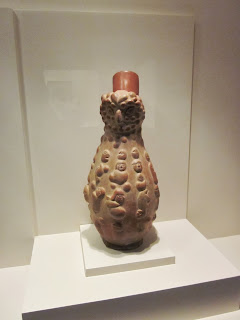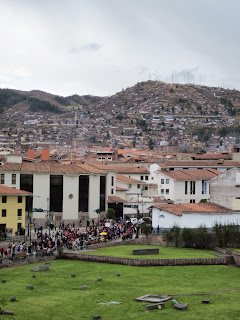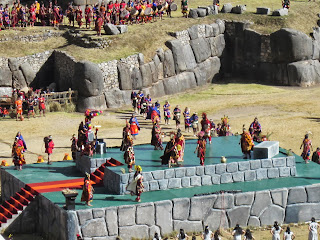Our first day in Cusco, a good week before the actual day of the Inti Raymi festival, there were already parades. We stayed right by the Plaza de Armas, and it was just non-stop action for our whole visit.
We were gone for 3 days to visit Machu Picchu and Ollanta and got back on Saturday afternoon. After dinner we were walking back to the Plaza de Armas and found that there was a concert happening. It looked like most of the city had gathered there and everyone had either Cusqueña (Cusco's main beer) or rum and cokes in hand. If you didn't have a drink, not to worry. Vendors were walking around selling both options, sometimes hilariously even pushing around shopping carts of booze.
Monday rolled around and it was time to head back up to Sacsayhuaman for the Inti Raymi festical. The festival is an annual recreation of the festival that occured on the winter solstice to the sun god, Inti. It used to take place within the city, but has been moved up to Sacsayhuaman to hold the thousands of visitors that come to see it every year. Everyone else just settles on top of the ruins' walls that make up the teeth and jaws of the puma's head.
The ceremony lasted about 2 hours in all with lots of jostling with the crowd to see, and it was entirely in Quechua.
The ceremony was really fun to see, but I think the highlight of the day actually came later that night. While we were relaxing at a cafe that overlooked the Plaza de Armas (foolishly thinking the festivities were all over), all these bands started to show up at the square. They each had a group of older men with large drums and pan flutes, and then younger men with just pan flutes. Many were accompanied by female dancers.
The Inti Raymi festival was set to take place on Monday July 24th, but the festival also has events for the entire week leading up to it.
Just getting out of our cab from the airport, we saw our first parade of the trip. Groups of dancers each had distinct costumes and dance routines. Needless to say, it was pretty great.
We headed over to Qurikancha, which used to be the most important temple in the Incan empire. Accordingly, its walls were covered in gold and it was filled with gold statues. When the Spanish took over Cusco, they demolished the temple and built a church over the foundations. You can still see some of the Inca stonework, but it is mostly Spanish architecture.
There were also local artists' work featured in the upper floors of the church. This artist made modern versions of the sacred Inca chalice used during religious ceremonies. The woodwork was great, and I loved his cheeky piece entitled "Ruins".
Just getting out of our cab from the airport, we saw our first parade of the trip. Groups of dancers each had distinct costumes and dance routines. Needless to say, it was pretty great.
We headed over to Qurikancha, which used to be the most important temple in the Incan empire. Accordingly, its walls were covered in gold and it was filled with gold statues. When the Spanish took over Cusco, they demolished the temple and built a church over the foundations. You can still see some of the Inca stonework, but it is mostly Spanish architecture.
 |
| The courtyard featured the rainbow flags that are supposed to represent the Incan empire. The one on the right is the older pattern, and the one on the left is now the flag for the Cusco province. |
 |
| This kid was the most adorable in his alpaca outfit. |
The outside of the structure featured a great garden built in terraces.
This was one of two paintings that were featured in the Church. This one represents the spiral structure that was how the Inca mapped their empire. It featured 4 quandrants, with Cusco as the capital in the middle. The intersection of the spiral and the rays were reference points to map the empire's settlements.
There was also a painting of the Incan constellations, which actually saw pictures from the black spaces between stars, instead of out of the stars themselves.
My photo didn't turn out, but you can see the painting here, showing constellations listed here.
The parades kept on going the whole day, and you could see and hear them going up the Avenida del Sol by the Qurikancha.
 |
| A neccessary coca tea break to adjust to the altitude. |
The best part of the parade was when they transitioned to kids' dance groups. Apparently each group respresented a different school.
 |
| These guys were dressed as hill guerillas, complete with fake rifles and acting out a fake battle. I couldn't help but think how this would NOT fly in the US. |
 |
| This was part of a delightful cowboys vs. indians sketch. |
Between the two concerts there was a brilliant fireworks show, launched from a convent that sat a bit higher up the hill.
Because we weren't expecting to have things to take pictures of, I didn't have my own camera, but I did find this shot of the fireworks over the city. You can see part of the Plaza de Armas on the right.
Because we weren't expecting to have things to take pictures of, I didn't have my own camera, but I did find this shot of the fireworks over the city. You can see part of the Plaza de Armas on the right.
There were also a series of paper maché statues that had been made by local artists. Many of them had political themes, lambasting corruption and rent-seeking by politicians. My favorite was a huge rat politician who had a briefcase with foreign money (yes, lots of US$s). However, there was also a giant armadillo made out of egg cartons which was also awesome.
Cusco is actally shaped like a Puma, and the head of the Puma is the temple Sacsayhuaman. It is about 2km above the city and features some GIGANTIC rocks in its stonework. Unfortunately, there were 3 towers that were dismantled by the Spanish so that they could use the stones to build new structures in Cusco proper. But the walls were still pretty much intact.
I was also surprisingly impressed by Cusco's museums. They had a pre-Colombian art museum (MAP), and an Inca museum.
Cusco is actally shaped like a Puma, and the head of the Puma is the temple Sacsayhuaman. It is about 2km above the city and features some GIGANTIC rocks in its stonework. Unfortunately, there were 3 towers that were dismantled by the Spanish so that they could use the stones to build new structures in Cusco proper. But the walls were still pretty much intact.
It also provided for a great view of the city:
 |
| This looks like a pose, but I think I was mostly exhausted from all the high-altitude stairs after hiking in Machu Picchu. |
I was also surprisingly impressed by Cusco's museums. They had a pre-Colombian art museum (MAP), and an Inca museum.
MAP was excellently curated, if the descriptions were a bit over the top. They had rooms dedicated to different cultures and time periods.
These gold earrings were from the Incas. I was interested to learn that what set Incan metalwork and pottery apart as exception were the ways that they could make perfectly symetrical pieces and perfectly replace patterns over multiple pieces. That replicability implied a level of craftmanship that most other pre-Colombian pieces lack.
These gold earrings were from the Incas. I was interested to learn that what set Incan metalwork and pottery apart as exception were the ways that they could make perfectly symetrical pieces and perfectly replace patterns over multiple pieces. That replicability implied a level of craftmanship that most other pre-Colombian pieces lack.
I also had to share these silver earrings. They stretched their ears large enough to actually wear these as studs.
This is an example of the type of langauge used in the descriptions. They were incredibly flowery and, while they were clearly trying to legitimize pre-Colombian art as at least as legitimate as European art, the language really seemed to reinforce ideas of primitivism and the "noble savage" more than anything...
 |
| This is a mythical representation of a potato. I'm unconvinced these curators know what this is. |
 |
| I really loved this owl pot. |
Monday rolled around and it was time to head back up to Sacsayhuaman for the Inti Raymi festical. The festival is an annual recreation of the festival that occured on the winter solstice to the sun god, Inti. It used to take place within the city, but has been moved up to Sacsayhuaman to hold the thousands of visitors that come to see it every year. Everyone else just settles on top of the ruins' walls that make up the teeth and jaws of the puma's head.
 |
| The Incan King addressing the sun. |
 |
| The dancers were in constant flux around the center stage. |
 |
| Here are the priests sacrificing the first of 2 llamas. |
 |
| Here is the high priest reading the llama's heart to discern the future. |
The ceremony lasted about 2 hours in all with lots of jostling with the crowd to see, and it was entirely in Quechua.
The ceremony was really fun to see, but I think the highlight of the day actually came later that night. While we were relaxing at a cafe that overlooked the Plaza de Armas (foolishly thinking the festivities were all over), all these bands started to show up at the square. They each had a group of older men with large drums and pan flutes, and then younger men with just pan flutes. Many were accompanied by female dancers.
Each of the bands would play over each other, trying to attract bigger crowds, until they all sort of came together in the middle and would just play concurrently. It was as if everyone was just cutting loose from dealing with the festival all day. Many of the younger guys playing just the pan flutes were also drinking whiskey or pisco straight from the bottle.
The structure of the bands seemed to be that the more experieced players who played both instruments had the more technically hard part of playing both instruments at the same time, and playing a full melody on their pan flutes. They younger boys who just had the pan flutes would not actually play a full melody, but would come in on specific notes, so that the melody was only played as a group. There was also periodic stanza of singing. All in all, I would love to be a member of this band, if these are the types of performances I could expect (although I'm pretty sure as a woman, I would not be allowed to play an instrument).
Each band had their own banner with a bannerman who vigorously danced and shook the banner to attract passerbys.
All in all, I can see why Cusco is known for being a party city. If you want more photos, check out the album of all my photos of our entire Cusco trip.





































No comments:
Post a Comment